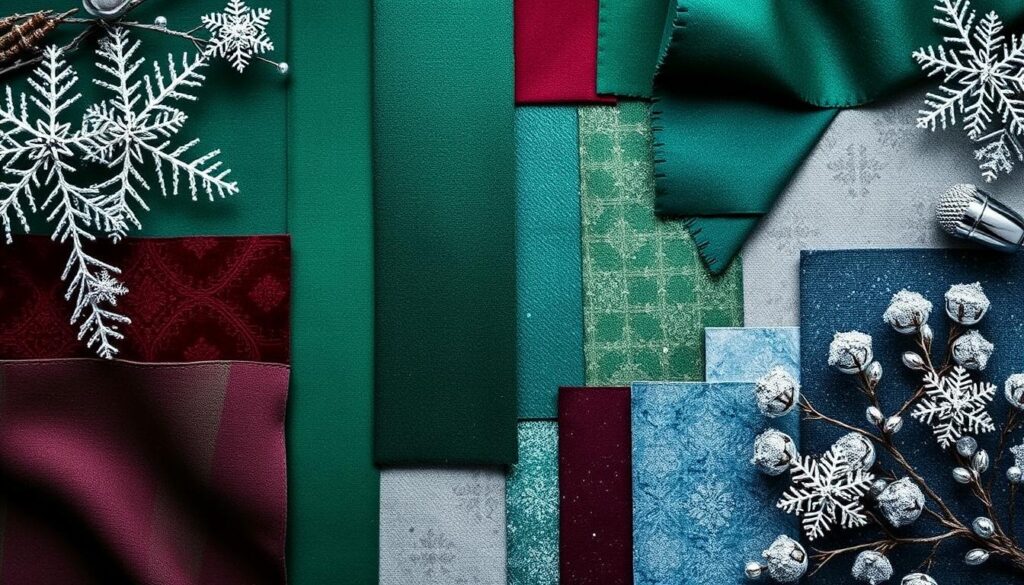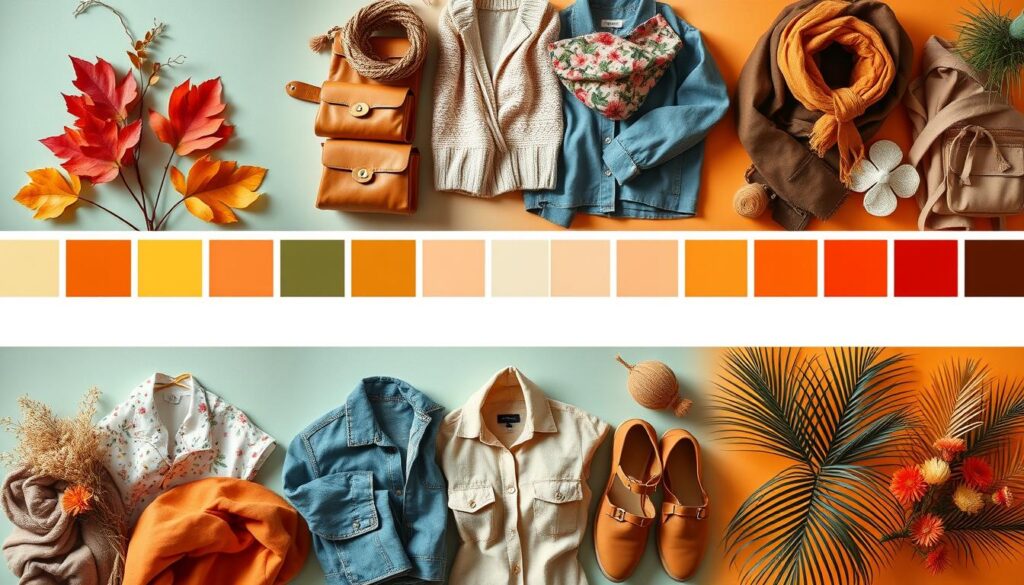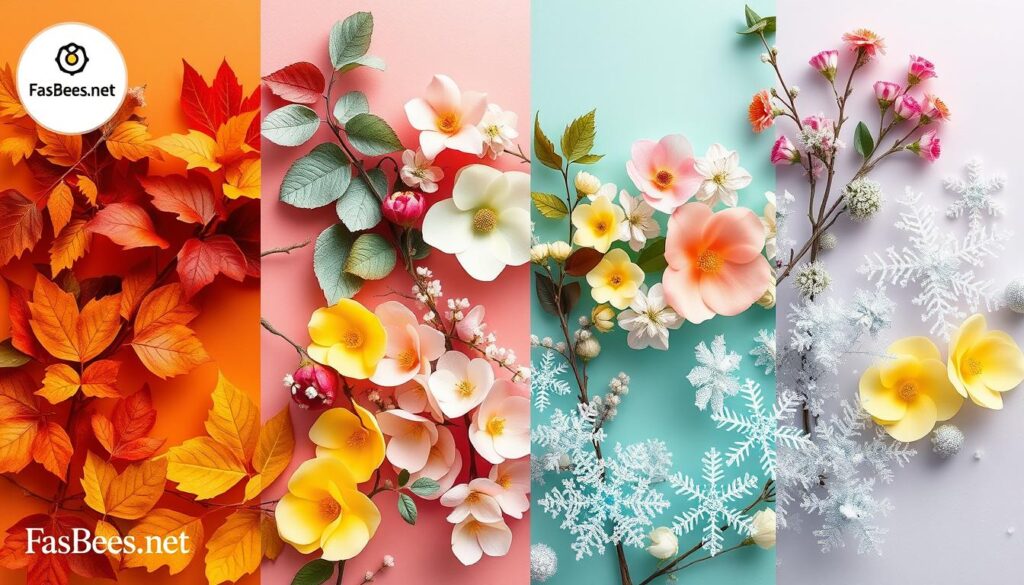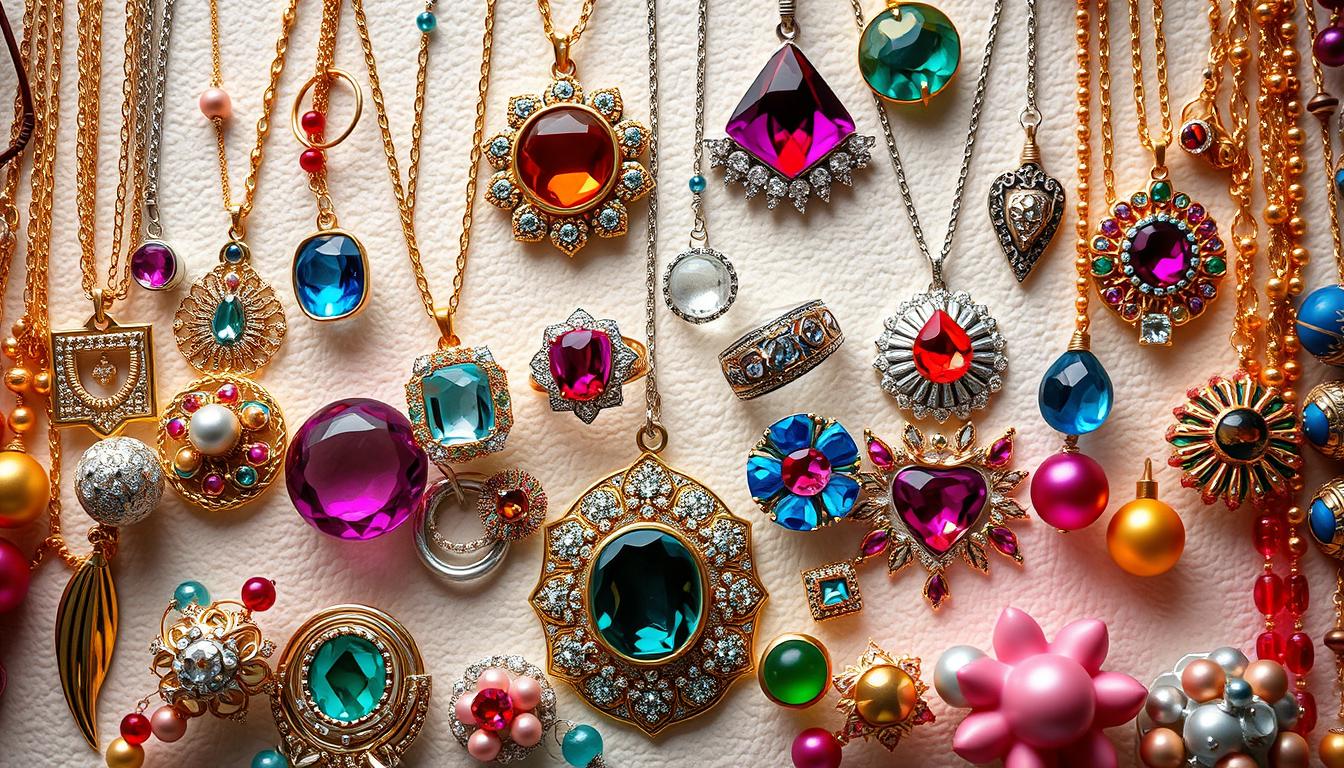Seasonal color analysis opens up a world of fashion tailored just for you. It helps find colors that look great with your skin, hair, and eyes. This way, you can build a wardrobe that makes you feel confident and shows off your style.
There are four main color palettes: spring, summer, autumn, and winter. Each has its own special colors and undertones.
Looking to tidy up your closet or find the perfect colors for you? Seasonal color analysis is the way to go. Experts use tools like color fans and drapes to find the best colors for you. They help you find a style that highlights your natural beauty.
Key Takeaways
- Seasonal color analysis helps identify the most flattering hues for your skin tone, hair, and eye color.
- The process categorizes color palettes into spring, summer, autumn, and winter, each with its own unique undertones and vibrancy.
- Curating a wardrobe around your personal seasonal color profile can boost confidence, simplify styling, and create a cohesive look.
- Color analysis tools like fans and drapes are used by professionals to determine the best shades for each individual.
- Incorporating seasonal colors into your wardrobe and lifestyle can elevate your personal style and create a harmonious aesthetic.
Understanding Seasonal Color Theory
Seasonal color theory has changed how we see fashion, interior design, and personal style. It divides people into four groups: Spring, Summer, Autumn, and Winter. This is based on their skin tone and coloring depth.
What is Seasonal Color Theory?
It looks at three color aspects: hue, value, and chroma. Hue is warm or cool, value is light or dark, and chroma is bright or muted. This helps find the best colors for each person. Carole Jackson’s book “Color Me Beautiful” made it popular in the 1980s. Now, there are 12 subtypes for more precise color matching.
How It Influences Fashion and Decor
Seasonal color theory has made a big difference in fashion and design. It helps stylists and designers pick the right colors for you. This makes you look good and feel confident in your style and home.
“Embracing your seasonal color palette is a game-changer in both fashion and interior design. It allows you to effortlessly create looks that make you feel confident and at home in your own skin.”
Learning about seasonal color theory can boost your self-expression and confidence. It helps in choosing the right colors for your style and home.
Identifying Your Seasonal Color Profile
Finding your seasonal color profile means looking at your skin tone, hair color, and eye color. Color analysts use tools like skin digitizers to measure your colors. They also try you in different fabrics to find the best colors for you.
Importance of Skin Tone and Undertones
Your skin’s undertone is key to finding your color profile. Undertones can be warm (yellow/golden), cool (pink/blue), or neutral. Knowing this helps pick colors that look good with your natural coloring.
Seasonal Color Test: How to Find Your Season
Experts suggest a color analysis test to find your season. You try on fabric swatches to see which colors look best. This test puts you into a season like Spring, Summer, Autumn, or Winter, and sometimes a subcategory for a more detailed personal color palette.
| Season | Characteristics | Recommended Colors |
|---|---|---|
| Spring | Warm, light, and bright | Pastels, soft yellows, greens, blues |
| Summer | Cool, light, and muted | Soft blues, lavenders, grays |
| Autumn | Warm, deep, and rich | Earthy tones, oranges, reds, browns |
| Winter | Cool, deep, and bold | Jewel tones, blacks, whites, silvers |
Knowing your seasonal color profile helps you pick clothes that make you look great. It makes your wardrobe look good together.
Spring Color Palettes: Bright and Fresh
Spring brings new life to the world, and colors follow suit. The palette shifts to light, clear, and warm tones. These colors are perfect for fair skin, making it glow naturally.
Recommended Colors for Spring
The best spring colors mix peach, aquamarine, and light yellows. These soft shades bring a youthful vibe. Adding coral and sunlit gold adds depth. Accessories in shimmering gold or delicate rose gold enhance the look.
For spring, avoid bold color contrasts like black and white. Instead, choose softer blends that look good together. This creates a beautiful, spring-inspired look.
Styling Tips for a Spring-Inspired Look
- Add pastel shades like pale pink, mint green, or lavender to your outfits and decor.
- Match light and warm colors with neutrals like beige, ivory, or gray for a balanced look.
- Use delicate jewelry in gold or rose gold to add a touch of elegance.
- Try spring patterns like floral prints, gingham, or polka dots for a playful vibe.
- Use natural textures like linen or cotton to keep your look fresh and airy.
Embracing spring’s light and warm colors makes your outfits and decor pop. It captures the renewal and rejuvenation of the season.
Summer Color Palettes: Cool and Vibrant
As summer arrives, the color palette changes to cool, vibrant hues. These colors are great for those with cool skin, hair, and eyes. The palette includes soft, muted tones that remind us of beach days and summer gardens.
Popular Summer Shades
The summer palette is inspired by the season’s calm colors. Soft blues, like powder and cornflower, bring the ocean’s calm. Delicate pinks, from pale rose to fuchsia, echo the beauty of fresh flowers. Soothing greens, from mint to sage, add a lush touch. Neutrals like soft grays and beiges complement these vibrant shades.
| Color Family | Specific Shades | Undertones | Best Suited For |
|---|---|---|---|
| Blues | Powder blue, cornflower blue, sky blue | Cool, calming | Light, medium, and deep skin tones with cool undertones |
| Pinks | Pale rose, fuchsia, dusty pink | Cool, soft | Fair to medium skin tones with cool undertones |
| Greens | Mint, sage, seafoam | Cool, refreshing | Light to medium skin tones with cool undertones |
| Neutrals | Soft gray, beige, ivory | Cool, versatile | All skin tones with cool undertones |
Combining Summer Colors in Outfits
To create summer outfits, layer colors from the same family. Wear a soft blue top with cornflower blue shorts. Add silver jewelry for a complete look. For a monochromatic look, pair a mint green dress with a sage cardigan and light gray sandals.
Try mixing pastel hues, like a dusty pink blouse with light aqua trousers. This creates a playful, summer look.

“The summer color palette is a breath of fresh air, offering a soothing and sophisticated alternative to the bolder hues of other seasons.”
Autumn Color Palettes: Warm and Earthy
As leaves change color and the air gets crisp, autumn is the perfect time for warm, cozy hues. These autumn colors bring comfort and a sense of home. They look great on anyone, whether your skin is warm or neutral.
Must-Have Autumn Hues
The best autumn colors come from nature, like changing leaves and pumpkin spice. Some key autumn hues are:
- Warm mustard yellows
- Mossy greens
- Mid-tone browns
- Rusts and ochres
- Soft, earthy oranges
Incorporating Autumn Colors into Your Wardrobe
Styling autumn colors is all about layering and mixing them in new ways. Wear pieces in earth-toned shades like olive, beige, and terracotta. Add fall color schemes like deep burgundy, mustard yellow, or rusty orange. Gold jewelry and accessories can also add to your warm tones.
“Autumn is a second spring when every leaf is a flower.” – Albert Camus
Embracing autumn’s rich colors lets you create stylish outfits that match the season. It’s a great way to celebrate the beauty of autumn.
Winter Color Palettes: Bold and Elegant
Winter color palettes focus on cool tones and bold, dramatic hues. These winter color combinations are perfect for those with cool undertones. They complement the skin beautifully. The colors often take inspiration from icy landscapes, snowy scenes, and dark nights.
Key Colors for Winter Style
The quintessential winter color palette includes shades like navy blue, deep red, and rich pink. These cool tones create a sophisticated and elegant look. They are perfect for the colder months. Avoid pastels and earthy colors, as they can wash out the complexion during this season.
Accessories to Complement Winter Looks
When styling winter outfits, silver jewelry works best to complement the bold colors. The icy gleam of silver accents pairs beautifully with the deep, cool hues of the winter palette. Incorporate silver in the form of necklaces, bracelets, and even metallic details on bags and shoes to complete the refined, winter-inspired look.
| Winter Color Palette | Primary Colors | Mood and Applications |
|---|---|---|
| Frosty Mornings | #B0E0E6, #A9C6D9, #6C7B8A, #4B5D67, #2C3E50 | Serene and tranquil, ideal for interior decor projects |
| Winter Wonderland | #FFFFFF, #E0F7FA | Relaxation and mindfulness, suitable for digital branding in wellness apps |
| Icy Blues | #E0F2F1, #0097A7 | Dynamic user experience, recommended for modern web designs |
| Snowy Nights | Deep charcoal to light gray | Sophistication and elegance, suitable for luxury fashion campaigns |

The key to mastering winter color palettes is to balance cool and warm tones. Experiment with textures and consider the emotional impact of the color choices. By testing color combinations in diverse contexts, designers and marketers can ensure the effectiveness of their winter-inspired designs across various elements.
“Winter weddings are considered an ‘off-peak’ season, resulting in lower wedding costs compared to peak seasons like spring and fall.”
Seasonal Color Palettes in Interior Design
Choosing the right colors for your home can really make a difference. It helps create a space that shows off your style. By picking colors wisely, you can turn your home into a true reflection of you.
Choosing Colors for Your Home
Choosing the right colors for your home is all about the lighting, room use, and mood you want. The undertones of colors matter a lot. For example, cherry wood floors give off a warm glow, which affects the colors you choose for walls and furniture.
Lighter colors are best for warmer seasons, while darker colors add coziness to big rooms. Warmer colors are good for rooms with little natural light. Cooler colors balance out bright sunlight. Knowing these tips helps you create a beautiful and engaging space.
Creating Balance with Seasonal Palettes
To make your home look balanced and cohesive, use seasonal color palettes. Experts recommend the 60-30-10 rule: 60% main color, 30% secondary, and 10% accent. This rule helps keep your design consistent while letting you change things up with accessories.
Seasonal colors can be used to change the mood of a room. For example, bright summer colors like raspberry and gray-blue can make a room feel lively. Rich autumn colors like rust and terracotta can make a room feel cozy. Choose colors that match your mood and style, even if they’re not the usual choices.
Learning about seasonal color analysis and how to use it in your home can change your living spaces. It makes them harmonious, visually appealing, and a true reflection of your style and preferences.
How to Transition Your Wardrobe Seasonally
Changing your wardrobe with the seasons can be easy with the right plan. Focus on key pieces that fit many seasons. This way, you can create a capsule wardrobe that’s both timeless and versatile. Mixing seasonal fashion colors smartly helps you update your style all year.
Essentials for Seasonal Wardrobe Swaps
Start with neutral basics like white tees, black pants, and beige cardigans. These pieces are great for layering and can fit many weather types and events.
For spring and summer, choose lightweight fabrics like cotton, linen, and rayon. In fall and winter, go for wool and velvet. Quality transitional outerwear, like trench coats and quilted jackets, helps bridge the seasons smoothly.
Tips for Mixing Seasonal Colors Year-Round
- Layering is key to incorporating seasonal colors into your wardrobe. Use lightweight tops, scarves, and accessories to add pops of color to neutral base layers.
- Accessorize with seasonal pieces like hats, bags, and jewelry to easily update your look. Scarves, in particular, are a versatile way to introduce seasonal hues.
- Create a capsule wardrobe with a cohesive color palette that allows you to mix and match items throughout the year. Stick to a few complementary shades and build your wardrobe around them.
By being mindful of your wardrobe, you can make your clothes last longer and look great all year. A bit of planning and creativity can keep your seasonal fashion looking fresh and functional.

“The key to a seamless seasonal wardrobe transition is to invest in high-quality, versatile pieces that can be easily layered and accessorized to suit the changing weather.”
Seasonal Color Palettes in Makeup
Choosing the right makeup colors for your season can really boost your look. It makes your natural beauty shine. Whether it’s spring’s fresh colors, summer’s sun-kissed glow, autumn’s warm tones, or winter’s bold elegance, picking the right colors matters a lot.
Best Colors for Each Season
In spring, go for peachy tones, soft pinks, and light lavenders. They give you a young and fresh look. Summer is all about soft pinks, lavenders, and bronzy shades for that sun-kissed glow. Autumn brings warm browns, oranges, and burgundies, perfect for the cozy season. Winter is for bold reds, cool neutrals, and dramatic smoky eyes, adding elegance to your look.
Seasonal Makeup Looks to Try
- Spring: Dewy, luminous skin with peachy cream blush and a touch of shimmery eye shadow
- Summer: Bronzed complexion, sheer coral lip, and a hint of lavender on the lids
- Autumn: Warm-toned matte eyeshadow, rich burgundy lip, and a touch of orange-toned blush
- Winter: Bold red lip, cool-toned smoky eye, and a hint of highlighter on the high points of the face
Remember your undertones when picking makeup colors. Warm undertones look great in autumn’s earthy tones. Cool undertones shine in winter’s bold colors. Trying out different palettes can help you find your best colors.
Matching your makeup to the season’s trends can make your look cohesive and polished. Embrace the seasonal color palettes to enhance your natural beauty all year round.
Crafting Your Own Seasonal Color Palette
Discovering your personal color palette can change how you see yourself. It lets you choose colors that make you look and feel great. Whether you’re a bright Summer or a calm Winter, creating your own color palette lets you show your true self.
Steps to Create Your Unique Palette
- Find out your seasonal color profile. Look at your skin, hair, and eyes to see if you’re warm or cool. This helps pick the right colors for you.
- Start with neutral shades. Shades like beige, gray, and black are good for any season. They make your wardrobe versatile.
- Pick your main colors. Choose colors that look good on you and make you feel bold. Summers might like bright pinks, while Winters might prefer deep plums.
- Add accent colors. Use colors that add fun to your look. Soft pastels are great for Spring, while Autumn loves rich jewel tones.
Tools and Resources for Color Inspiration
Get creative with color inspiration everywhere. Use online color wheel apps, check out fashion magazines, or look at nature’s colors. Social media sites like Pinterest and Instagram are full of beautiful color ideas.
For a detailed color analysis, try special services or apps. They can show you the best colors for you. With some exploring, you’ll find a palette that matches your style and season perfectly.

“Surrounding yourself with colors that make you feel vibrant and alive is the ultimate act of self-care.”
The Impact of Color Psychology
Color psychology is a field that looks into how colors affect our mood and feelings. Different colors can make us feel certain ways, like the bright colors of spring or the warm tones of autumn. The colors we choose can change how we feel and see our surroundings.
How Colors Affect Mood and Perception
Warm colors like red and orange make us feel energetic and excited. Cool colors like blue and green help us relax and feel calm. Color psychology shows how colors can change how we see others and our world.
Wearing bright yellow can make you seem more lively and friendly. On the other hand, wearing gray can show you’re confident and sophisticated. Choosing colors that match our style can boost our mood and confidence.
Colors that Evoke Seasonal Feelings
- Spring colors like pastel yellow and green make us feel hopeful and refreshed.
- Summer colors like yellow and orange bring happiness and energy, just like the sun.
- Autumn colors like earthy browns and rust make us feel cozy and comfortable.
- Winter colors like black, deep red, brown, and white keep us warm and snug.
Knowing how colors affect us can help us choose the right colors for our clothes, homes, and style. This way, we can create spaces that make us feel good and match the season.
“Colors have a profound impact on our mood, behavior, and overall well-being. Understanding the psychology of color can help us create living and working spaces that inspire, energize, and soothe us.”
Finding Inspiration for Seasonal Color Ideas
Exploring the perfect seasonal color palette is an exciting adventure. There are many online resources and current trends in fashion and design to inspire you. Color palette generators, design blogs, and platforms like Pinterest and Instagram are full of ideas. They show you how to mix colors in creative ways.
Keeping up with the latest color forecasts from Pantone and fashion weeks is key. Nature, art, and culture also offer great color inspiration. They help you create unique and meaningful color palettes for your style and home.
Dive into the world of color to understand how it can enhance your fashion, home decor, and style. Let the changing color trends inspire you. Create a style that shows off your personality and the seasons.



